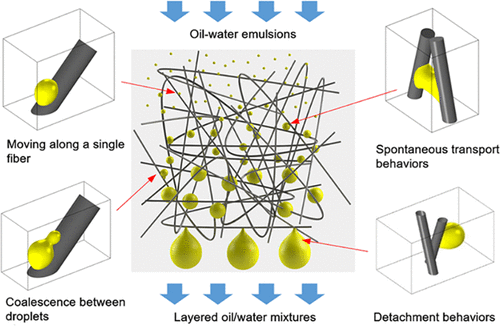Our official English website, www.x-mol.net, welcomes your
feedback! (Note: you will need to create a separate account there.)
Simulation Study on the Dynamic Behaviors of Water-in-Oil Emulsified Droplets on Coalescing Fibers
Langmuir ( IF 3.7 ) Pub Date : 2020-11-24 , DOI: 10.1021/acs.langmuir.0c02948 Chaolang Chen 1 , Lei Chen 1 , Ding Weng 1 , Xuan Li 1 , Zhaoxin Li 1 , Jiadao Wang 1
Langmuir ( IF 3.7 ) Pub Date : 2020-11-24 , DOI: 10.1021/acs.langmuir.0c02948 Chaolang Chen 1 , Lei Chen 1 , Ding Weng 1 , Xuan Li 1 , Zhaoxin Li 1 , Jiadao Wang 1
Affiliation

|
Although increasing superwetting membranes have been developed for separating oil–water emulsions based on the “size-sieving” mechanism, their pores are easily blocked and fouled by the intercepted emulsified droplets, which would result in a severe membrane fouling issue and a sharp decline in flux. Instead of droplet interception, a fiber-based coalescer separates oil/water emulsions by inducing the emulsified droplets to coalesce and transform into layered oil/water mixtures, exhibiting an ability to work continuously for a long time with high throughput, which makes it a promising technology for emulsion treatment. However, the underlying mechanism of the separation process is not well understood, which makes it difficult to further improve the separation performance. Hence, in this work, the dynamic behaviors of water-in-oil emulsified droplets on the surface of the coalescing fiber were numerically investigated based on the phase-field model. The attachment, transport, and detachment behaviors of droplets on fibers were directly observed, and the effects of fiber wettability, orientation, arrangement, and fluid speed were studied in detail. First, it was observed that the droplets will move downstream along the fiber surface under the effect of fluid shear, and the large droplets tend to coalesce with their downstream small droplets on the same fiber surface because they move faster compared to the small droplets. Second, it was found that the emulsified droplet will spontaneously transport to the intersection of two angled fibers under the drive of asymmetric Laplace pressure, which demonstrated that the emulsified droplets tend to gather at the intersection of fibers when permeating through a coalescing medium. Third, it was found that the detachment behaviors of droplets from the fiber surface are strongly affected by their size, fiber wettability, and fluid velocity. In addition, the results of our simulation show that the backside of two closely attached fibers can further inhibit the detachment of droplets. We truly believe that our research results are of significance to optimize the parameters of a fiber-based coalescer for separating oil–water emulsions and to develop novel oil/water separators.
中文翻译:

聚结纤维上油包水型乳化液滴动态行为的模拟研究
尽管基于“筛分”机理已经开发出了越来越多的超湿膜来分离油水乳液,但它们的孔很容易被截留的乳化液滴堵塞和污染,这将导致严重的膜污染问题和膜的急剧下降。通量。基于纤维的聚结剂可以通过诱导乳化的液滴聚结并转化为分层的油/水混合物来代替油/水乳液,从而能够长时间连续工作且具有高通量,这使其前景广阔乳液处理技术。然而,分离过程的基本机理还没有被很好地理解,这使得难以进一步提高分离性能。因此,在这项工作中 基于相场模型对油包水乳化液滴在聚结纤维表面的动力学行为进行了数值研究。直接观察液滴在纤维上的附着,运输和分离行为,并详细研究了纤维润湿性,取向,排列和流体速度的影响。首先,观察到在流体剪切作用下,液滴将沿着纤维表面向下游移动,并且大液滴倾向于与它们在同一纤维表面上的下游小液滴聚结,因为与小液滴相比,它们移动得更快。其次,发现在不对称的拉普拉斯压力的驱动下,乳化的液滴会自发地运输到两个成角度的纤维的交点,这表明乳化的液滴在渗透通过聚结介质时趋向于聚集在纤维的交点处。第三,发现液滴从纤维表面的分离行为受其尺寸,纤维润湿性和流体速度的强烈影响。此外,我们的模拟结果表明,两条紧密连接的纤维的背面可以进一步抑制液滴的分离。我们坚信,我们的研究结果对于优化用于分离油水乳状液的纤维基聚结器的参数以及开发新型油水分离器具有重要意义。纤维的润湿性和流体速度。此外,我们的模拟结果表明,两条紧密连接的纤维的背面可以进一步抑制液滴的分离。我们坚信,我们的研究结果对于优化用于分离油水乳状液的纤维基聚结器的参数以及开发新型油水分离器具有重要意义。纤维的润湿性和流体速度。此外,我们的模拟结果表明,两条紧密连接的纤维的背面可以进一步抑制液滴的分离。我们坚信,我们的研究结果对于优化用于分离油水乳状液的纤维基聚结器的参数以及开发新型油水分离器具有重要意义。
更新日期:2020-12-08
中文翻译:

聚结纤维上油包水型乳化液滴动态行为的模拟研究
尽管基于“筛分”机理已经开发出了越来越多的超湿膜来分离油水乳液,但它们的孔很容易被截留的乳化液滴堵塞和污染,这将导致严重的膜污染问题和膜的急剧下降。通量。基于纤维的聚结剂可以通过诱导乳化的液滴聚结并转化为分层的油/水混合物来代替油/水乳液,从而能够长时间连续工作且具有高通量,这使其前景广阔乳液处理技术。然而,分离过程的基本机理还没有被很好地理解,这使得难以进一步提高分离性能。因此,在这项工作中 基于相场模型对油包水乳化液滴在聚结纤维表面的动力学行为进行了数值研究。直接观察液滴在纤维上的附着,运输和分离行为,并详细研究了纤维润湿性,取向,排列和流体速度的影响。首先,观察到在流体剪切作用下,液滴将沿着纤维表面向下游移动,并且大液滴倾向于与它们在同一纤维表面上的下游小液滴聚结,因为与小液滴相比,它们移动得更快。其次,发现在不对称的拉普拉斯压力的驱动下,乳化的液滴会自发地运输到两个成角度的纤维的交点,这表明乳化的液滴在渗透通过聚结介质时趋向于聚集在纤维的交点处。第三,发现液滴从纤维表面的分离行为受其尺寸,纤维润湿性和流体速度的强烈影响。此外,我们的模拟结果表明,两条紧密连接的纤维的背面可以进一步抑制液滴的分离。我们坚信,我们的研究结果对于优化用于分离油水乳状液的纤维基聚结器的参数以及开发新型油水分离器具有重要意义。纤维的润湿性和流体速度。此外,我们的模拟结果表明,两条紧密连接的纤维的背面可以进一步抑制液滴的分离。我们坚信,我们的研究结果对于优化用于分离油水乳状液的纤维基聚结器的参数以及开发新型油水分离器具有重要意义。纤维的润湿性和流体速度。此外,我们的模拟结果表明,两条紧密连接的纤维的背面可以进一步抑制液滴的分离。我们坚信,我们的研究结果对于优化用于分离油水乳状液的纤维基聚结器的参数以及开发新型油水分离器具有重要意义。











































 京公网安备 11010802027423号
京公网安备 11010802027423号